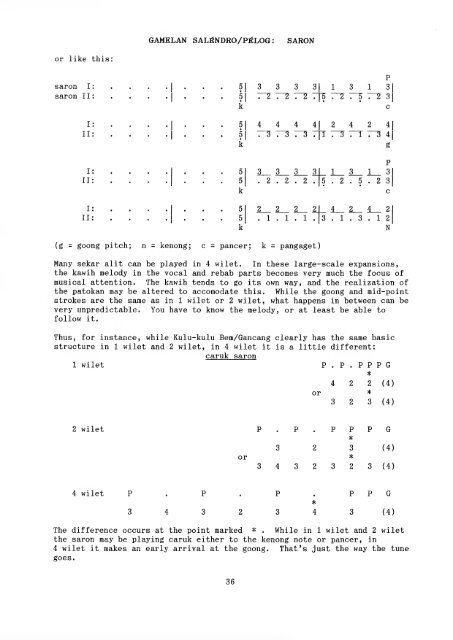Guide to Sundanese Music - Free EBooks Library
Guide to Sundanese Music - Free EBooks Library
Guide to Sundanese Music - Free EBooks Library
You also want an ePaper? Increase the reach of your titles
YUMPU automatically turns print PDFs into web optimized ePapers that Google loves.
or like this:<br />
saron I<br />
saron I I<br />
I:<br />
II;<br />
GAMELAN SALfiNDEO/PlgLOG : SARON<br />
I:<br />
II; 2.2.2.<br />
I:<br />
5<br />
k<br />
k<br />
I 3 3|<br />
• ^ t £i * ^•tO« Li • 0* Ci o \<br />
P<br />
3 1 3|<br />
4 4 4 4| 2 4 2 4(<br />
r~57^7~J7TT7~57~Tr34|<br />
c<br />
P<br />
3 1 3<br />
2.5.23<br />
c<br />
II: 1 2<br />
N<br />
(g = goong pitch; n = kenong; c = pancer; k = pangaget)<br />
Many sekar alit can be played in 4 wilet. In these large-scale expansions,<br />
the kawih melody in the vocal and rebab parts becomes very much the focus of<br />
musical attention. The kawih tends <strong>to</strong> go its own way, and the realization of<br />
the pa<strong>to</strong>kan may be altered <strong>to</strong> accomodate this. While the goong and mid-point<br />
strokes are the same as in 1 wilet or 2 wilet, what happens in between can be<br />
very unpredictable. You have <strong>to</strong> know the melody, or at least be able <strong>to</strong><br />
follow it.<br />
Thus, for instance, while Kulu-kulu Bem/Gancang clearly has the same basic<br />
structure in 1 wilet and 2 wilet, in 4 wilet it is a little different:<br />
caruk saron<br />
1 wilet P . P . P P P G<br />
*<br />
2 wilet<br />
4 wilet P<br />
3 4<br />
P<br />
3<br />
or<br />
P<br />
3<br />
P<br />
4 2 2 (4)<br />
or *<br />
2<br />
3 2<br />
*<br />
4<br />
3 2 3 (4)<br />
p<br />
*<br />
3<br />
*<br />
2








